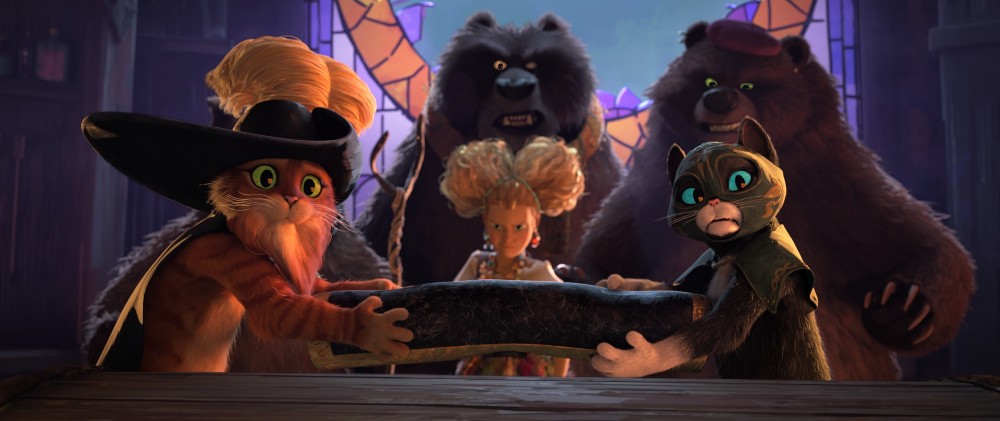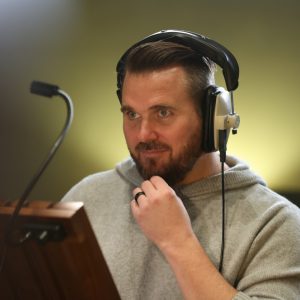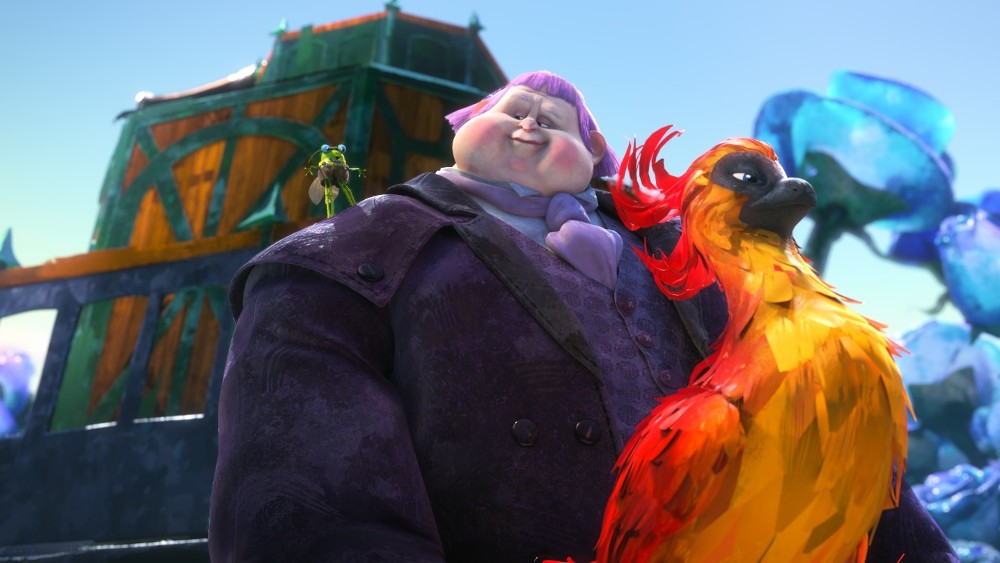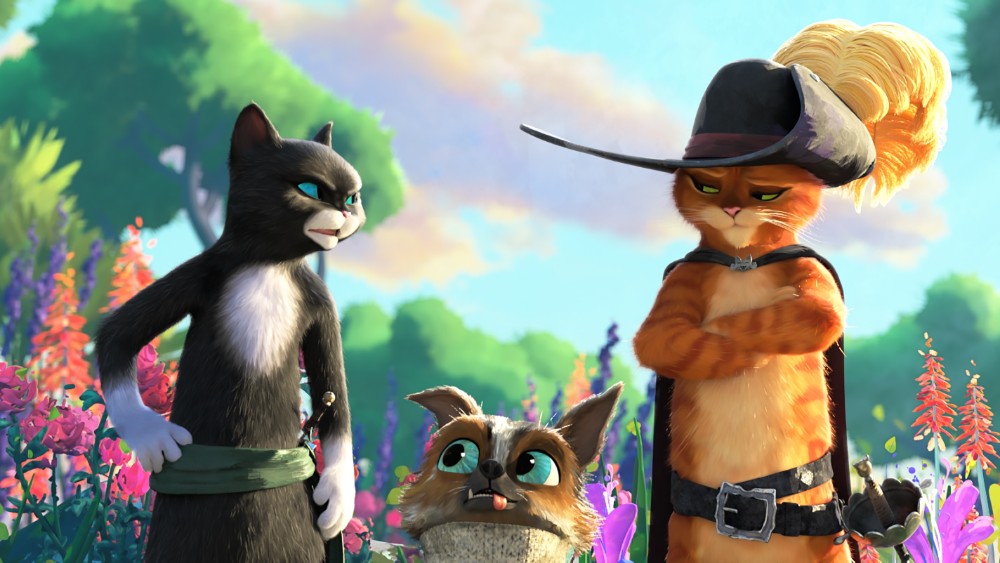For more than two decades, DreamWorks Animation (DWA) has been at the cutting edge of computer animation while also constantly pushing the limits of storytelling in that medium. Director Joel Crawford has now been in charge of two recent DWA sequels — The Croods: A New Age in 2020, and its latest release Puss in Boots: The Last Wish, which is meow, excuse me, now playing in theaters.
A sequel to the 2010 Shrek spin-off, The Last Wish once again features the voice of Antonio Banderas as feline adventurer Puss in Boots, who after one particular conflict with a giant discovers that he only has one of his nine lives remaining. He heads off to find a Wishing Stone that can help him recover some of his lives, but others are also looking for it, including the John Mulaney-voiced Jack Horner, and Goldilocks (voiced by Florence Pugh) and her family of three bears, voiced by Ray Winstone, Olivia Colman, and Samson Kayo. Salma Hayek is also back voicing Puss’ ex, KItty Softpaws.
There’s a lot that separates The Last Wish from other kiddie flicks, as it combines the similarly edgy humor of the Shrek movies with twisted takes on classic fairy tale characters, but it’s also the look of the movie that’s so striking because it blends modern computer animation with things that look like they were 2D hand-drawn.
Below the Line spoke with Crawford a few years ago for DreamWorks Animation’s The Croods: A New Age, and it was great to follow up with him on his second sequel for DWA, revisiting a popular character from the studio’s groundbreaking Shrek series.

Below the Line: It’s only been two years since we spoke for The Croods, and I know that animated movies often take three or four years, so what was the timeframe for you coming on to direct Puss in Boots?
Joel Crawford: For animation, it’s pretty quick to have another movie out a couple years later. By the time you and I were speaking, we were done on Croods and starting to jump onto the next project, which was The Last Wish, so we had a little bit of lead on that. Essentially, for an animated movie, it was kind of a quick process. However, the one thing we had, and the reason I think this came together so well and so quickly, is because the studio was trying to make this movie for over 10 years. They knew they wanted a sequel, and they kept bringing in many filmmakers [and[ writers, and the project would start.
Basically, there was a lot to build on and lots to learn from, by the time I approached the project. Our mindset was like, “Let’s work with what works, and then find our voice and what we want to say about this.” Really, the nugget of the idea that just kind of leapt off the page to me was about a cat on his ninth life [laughs] — it’s so rich. It’s so ridiculous, Puss in Boots being on his last life, it feels like a fairy tale. But then, it’s really about realizing you get one go at this, you get one life, and thinking we could put this absurdity with the reality and make this a special message, which is about appreciating life.
BTL: When we spoke for Croods, you mentioned how tough sequels can be because you have to find a story that justifies making them. Was that idea of Puss in Boot’s 9th life something you brought in, or was that something that was always part of the idea?
Crawford: Like I was mentioning on Croods, just finding what’s the next big story so it doesn’t feel like you’re just continuing or doing more of the same, but there’s a reason for this next chapter with these beloved characters. For me, that idea of wow, this is a big story. This is about the life we all get, and it raises questions of how are you going to live it? Who are you gonna share it with? For that element, that was kind of a no-brainer. It was like, ‘Yes, this is [the] next chapter.’
I think tone was interesting to find on this, because as I probably mentioned when I was talking to you about Croods: A New Age, I love comedies, and I love approaching things in that way where there’s just something so great about comedy itself, because it’s a disarming way to tell the truth. We did approach this much like the first Puss in Boots and the whole Shrek world. It’s heavily laid in this edgy comedy, and that’s where we started, but along the journey, we discovered in order to really feel the weight of the story, we needed to go to some new tonal territory. For us, that was inspired by Grimm fairy tales.
BTL: Did you happen to work on any of the earlier Shrek movies or the first Puss in Boots at all?
Crawford: I had the opportunity to storyboard for a while on Shrek Forever After with [Director] Mike Mitchell. I didn’t work on the Puss in Boots movie as a storyboard artist, but on Shrek Forever After, I storyboarded a whole backstory of Puss in Boots in this alternate world, and really got to discover the character as an artist there. The scene ended up getting cut, but it was great research for me.

BTL: I’ve watched the movie a couple of times, ad I’m amazed that there are so many fairy tale characters and jokes that haven’t shown up in other Shrek movies. For instance, how has Jiminy Cricket not been used before, or Goldilocks and the three bears? Did you have to go through the fairy tales to figure out what you could use in this one?
Crawford: That mindset was definitely like, here’s our challenge. Once we let go of who’s in this story, we just follow what we needed for story ingredients, and led us to these conclusions. I’ll give you two examples: For us, we feel like Puss in Boots lives in two worlds. One has a boot placed heavily [in] the Shrek fairytale world, but also the other boot [is] in the Sergio Leone spaghetti Western world. A template for myself and the co-director, Januel Mercado, was The Good, the Bad and the Ugly, because we said this is a story about all these characters after this treasure. For us, we filled in like, “Who is the good? Puss in Boots, Kitty Softpaws and Perrito. Who’s the bad? Jack Horner, the hilarious voice of John Mulaney, is the bad,” and then for us, we said “The Good, the Bad and the Goldie.” We kind of found Goldilocks and the Three Bears being antagonists, but they’re not bad. They’re just misunderstood.
Those were our core ingredients, and then with… we call him “Ethical Bug,” the cricket from the Pinocchio world, he came from… John Mulaney, he’s so funny with being bad as Jack Horner, but we wanted to have someone for him to play off of. For a long time, I wished Perrito – because he is so pure and innocent – could be with Jack Horner — the devil and angel. And for the story, we needed the dog to be with Puss and Kitty. We needed him to be with the bears to really influence them. The writer, Paul Fisher, in one of our story meetings was like, “What about Jiminy Cricket?” And so, we ended up kind of being inspired by kind of like a mash-up of the cricket, but also Jimmy Stewart, harkening to the Frank Capra squeaky clean look at the world. And so, that just like felt like, “That’s perfect. We have to do that.”
BTL: Who ended up doing the Jimmy Stewart impression?
Crawford: I’m glad you asked. He is our story edit supervisor. He works on the side of production, and he just did this amazing Jimmy Stewart-inspired voice. A lot of times, as we put these screenings up, we do temporary voices until we find the right execution of the scene and the right actor. But right from that screening where we put him in, it was like, “This is working,” and Mark Swift, the producer, was like, “Let’s not change it,” so Kevin McCann is the voice of “Ethical Bug.”

BTL: I feel like everyone at DreamWorks Animation eventually ends up voicing a character. I also wasn’t too familiar with the actor who voices Perrito either, and he steals many scenes. Was that an actor?
Crawford: Yes, so Harvey Guillén, [an] amazing, talented actor, who actually himself brings this incredibly honest and positive worldview, he really brought so much to the part of Perrito. Harvey is in What We Do in the Shadows, that FX show, as Guillermo, and Harvey’s just so charming and funny, so when we were figuring out this innocent, sweet character, it was like, ‘Oh, this has to be Harvey Guillén.’
BTL: Are you involved with pitching to actors and getting them on board? It’s amazing when you can get the likes of Florence Pugh and Olivia Colman and Ray Winstone, but also convince John Mulaney to voice a bad guy. What’s your pitch normally to get them to commit?
Crawford: I’m so glad you asked, because depending on how busy [the actors] are, it can be different versions of getting them on board. One of the unique things on this movie was we did pitch to each actor. I went and walked them through the story. It’s really a conversation, because one of the special things was each actor, when I’d walk them through the story, brought their own unique point of view to the character, which related to the theme. I knew I’d get an amazing cast and amazing performances, but what I didn’t know I was gonna get was almost like co-writers in all the actors. They were all so invested, from Antonio to Salma to John Mulaney, to Florence Pugh.
When I was pitching to John Mulaney, he so quickly when I was talking about how Jack Horner was after this Wishing Star, because he never got any respect as a child, being inspired by a nursery rhyme, and he wants all the magic. John was so quick at going, “This is about a guy who is searching for this external source of happiness to fill his inner void.” He so quickly crafted all the humor around that theme. And then with Salma, we had these conversations where we would keep delving deeper. It wasn’t even about the humor. It was about, psychologically, what is going on with this character? [With] Salma, we just were able to craft making sure it didn’t feel like a cartoon. These are all well-defined characters who have their own path and their own reason they’re after Wishing Star, so yeah, it was a gift to have this amazing cast.
BTL: Do you still film all the actors while they’re doing their voice recording as reference for the animators? Is that still a common thing over at DWA?
Crawford: Absolutely. They call it a lipstick cam. The animators are able to really find these nuances that the actors bring, and then be equal partners in tracking their characters throughout the movie. We have supervising animators on each of the characters, because you’ve got 60 to 80 animators on these movies. Even though they have the visual reference from the actor’s performance, there’s so much in the way. Take the bears, for example. Ray Winstone gives you this great facial acting, but there’s so much in the body of how a bear moves, and specifically, how Papa Bear moves, that you need an animator to be able to track that all the way through. Our Head of Character Animation, Ludovic Bouancheau, was just amazing at making sure there was this consistency and the same well-rounded depth to each character, so they all come off as unique.

BTL: I remember speaking to someone for the first Madagascar movie, and they were telling me they would cast specific animators for each character, which I think is rather unique for studio-driven animation.
Crawford: I’ve been here at DreamWorks for over 17 years, so it’s my only experience with it in-house, knowing how animation works. It just really works so well to find these characters, where you have different animators animating them, but a supervisor who will guide those animators to the nuances.
BTL: Do you still record each actor separately? I imagine with COVID, that was equally important and maybe you were doing some of the recording with the actors remotely, but there are so many moments where it seemed like recording them together could add more, particularly with Antonio and Salma, who have been working together for nearly 30 years, and even Goldie and the three bears.
Crawford: So the answer is “No,” we had them all separate, but like you mentioned with Salma and Antonio, it’s such a great gift that they know each other so well. I remember we were gonna play a clip of a line from Antonio for [Salma] to react to, and she goes, “‘ou don’t need to play it. I know how he’d say it,’ and then she did this amazing impression of him. They’re like brother and sister; they know each other so well. We would improvise a lot, and so [Salma] would go, ‘Oh, what if I said this, because then Puss could do this,’ and we would then either write that into the script for Antonio or playback [Salma’s part]. There’s a lot of trying to find that spontaneity, as if they were in the same room, which I think comes from not just settling for what we have on the page, but trusting and going, “Let’s improvise, and let’s see where this goes.”
Even with Florence Pugh and Samson Kayo, that relationship between Goldilocks and Baby Bear. We would play clips for both of them, and they’re so wonderful at thinking about the other’s performance. Florence knew how wonderful [Samson] plays this giddy excitement, and a lot of her hyping up Baby in the movie, she’s going, ‘Oh, is that what you want? Yeah?’ That came from Florence going, ‘Oh, I have to let him talk, and then I’m gonna go up a level, and then we’re gonna let him talk again.’ We would just find this great chemistry that when you watch the movie, it feels like they’re in the same place.
BTL: I’m glad we talked about the actors since I think there’s some cynicism — and as a film critic, I’ve been guilty of it, too — that most of these actors are doing voices for animation for the paycheck, and because it’s such a quick thing. They can just go into the studio for a couple of days, and then they’re done. But what you’re telling me is very different from the impressions that some may have about these big-name actors lending their voices to animation.
Crawford: I kind of had the same thought. That’s why I said this was a unique, special experience, because that’s kind of what you’d expect — that they’re busy, they come in for a day, that you’ve got the lines in front of them, you give them context, but the wonderful surprise was all of them wanted to make this something special. They were so trusting to really go to some surprising areas, at the end, trusting that I would use the best takes, but really, that’s what made it really, really sweet.
This might be kind of a spoiler but Ray Winstone, when we were pitching him the movie, I was walking through how this little orphan girl discovered the bears and you’ve got this edgy cockney crime family. When I got to the part where I pitched him that Goldie accidentally lets out what her true wish would be — that she wants a human family — Ray, he’s just so in the moment, that he just said, ‘I guess some people just stick around until the porridge is gone.’ That was his reaction in the pitch, so we were like, ‘Well, [we’re] writing that into the script.’ So many of those instances just came from them really just being genuinely invested. I think we found something special, because of it.

BTL: Let’s talk about the look of the movie, which seems to mix 2D and 3D animation styles. We definitely seem to be in the post-Katzenberg DreamWorks where you can experiment more with the look of the animation. Can you talk about how you wanted to approach the look of this movie vs. even the first Puss in Boots?
Crawford: It’s interesting how it’s been such a journey with animation. When CG animation first came out, it was impressive to audiences that you could see the details, the fur on an arm, the freckles on a face, and that chasing photorealism was a big part of the early CG when Shrek came out. But as animation has evolved, and as audiences have, I think, become more sophisticated, it’s really allowed for us, as artists, to get more specific, not chase real life, but we’re creating animated worlds and really opened the floodgates of going these movies can look so many different ways, here doesn’t have to be a house style of CG animation. Nate Wragge, the Production Designer, really crafted and spearheaded this idea of what if Puss in Boots looked like he was in a fairy tale painting.
That was so exciting, but also when you’re in new territory, it’s a lot of trial and error. Even though Spider-Verse had come out a few years before, and really pushed towards comic book style, because this was a painting, we were kind of crafting our own execution in a way. How much is this 2D feel [and] how much is CG? We really had to find the right balance, almost scene to scene as we were lighting them. The technology they have is amazing where they could fragment the models, like the locations, and make them look like they’re not just clean lines that look like hard CG volume, but that it looks like if you’re looking at a painting, and then in your peripheral, things are looser, that technique they use to where brushstrokes are seen and things aren’t totally connecting. So you feel it, and it’s impressionistic versus literal. That was just so exciting to work on a story that we expanded our toolbox, [because] we want to get across a feeling, and you have more tools to use, to tell a more specific story.
BTL: When it comes to animators or artists that have been at DWA a long time, is it tough to get them to change the way they work, or are they so excited to try new things, they’re suggesting new ways of how things could look?
Crawford: Really, there was this excitement that kind of snowballed, because when you say, ‘This needs to be impressionistic,’ that’s so open-ended, that artists creatively get excited off it. Like I was saying, [there] was trial and error, but there were so many things that kept getting pushed. The animators, some had just done traditional CG animation where everything is on ones and smooth, and we’d switch to step animation [where] we’d hold certain poses for, instead of one frame, we’d go to like two frames, three frames, four frames, and you get this exaggerated feel.
There were some animators who hadn’t done it before, but really just dove in and found the look of it. Even our effects department, led by James Jackson. A lot of effects, say, like, dust and explosions, in CG, they are simulations, algorithms of how you want everything to hit. On this movie, it was a combination of textures, from paintings, of hand-drawn 2D effects, and the CG effects. There were effects artists who don’t draw, who are learning to draw while on this, and I had no idea because their work was amazing. I was like, ‘You’ve just learned to draw?’ It was inspiring that people were just so excited to stretch and go to new territory.
BTL: I want to ask you a question that I haven’t asked any other animation directors ever, but it’s been something on my mind lately, since below-the-line people — say production designers, cinematographers, and yes, even directors in animation — often don’t receive acknowledgment at the Oscars outside of the Animated Feature category. Obviously, there are the Annies who present awards to those crafts, but I wondered if you have any thoughts about that, not only just towards directing but also regarding some of your team and heads of department?
Crawford: Oh, I love that question. It’s interesting, because we talked about the look of the movie, and I mentioned Nate Wragge, who’s a production designer, who I worked with on Croods, as well. In finding the artistic way to express the vision of the movie, but right alongside, the Visual Effects Supervisor, Mark Edwards, was just as creative at figuring out how we could achieve a lot of these things that would start as a painting. The production designer and the visual effects supervisor are kind of hand in hand with each other. The one thing that a lot of people have been commenting on in Puss in Boots is the cinematography [and] the camera work, which we really worked hard to bring the audience into Puss’s worldview and feel the action, whether it’s exciting or scary.
Chris Stover, the head of layout, was essentially such the vision, the eye behind that camera. I feel like, yes, there’s so much that goes into these movies. There are over 400 people that worked on this one. As a director, I experience that, and appreciate it, and I don’t know that everybody who is just watching the movie, really is able to understand and grasp how much love and passion goes into these movies and how much skill. That’s why I’m like, I love that question.
But I think you’re right where it’s not really… there’s the Annies and there’s the Visual Effects Awards (VES). There are those things, but I guess for me, it’s like getting that into the mainstream. One of the nice things at the premiere was doing these interviews with Salma Hayek, and when I mentioned how many people worked on the movie, she was just like, “Wow,” and so she started to be excited to tell people about that. I think that’s what I mean is [that] if the mainstream audience could know how much goes into these, I think they would appreciate them even more.
Puss in Boots: The Last Wish is now playing in theaters nationwide courtesy of DreamWorks Animation and Universal Pictures.





